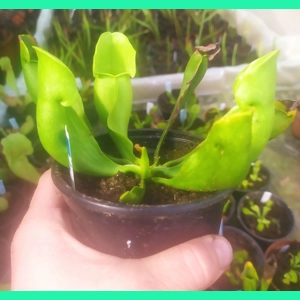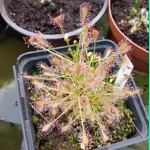Sarracenia purpurea subsp. purpurea f. heterophylla
Sarracenia purpurea subsp. purpurea f. heterophylla is a rare antho-free version of the hardiest Sarracenia. It can survive winters to -50C and is therefore best grown as an outdoor plant.
Sarracenia purpurea is distributed on the Eastern seaboard, the Great Lakes region, Canada except Nunavut and Yukon, Washington state, and Alaska. That makes it the most common and broadly distributed pitcher plant, as well as the only member of the genus that inhabits cold temperate climates.
It is endangered or vulnerable over much of the southern part of its range.
It is an introduced and naturalized species in Europe and the northwestern US, so far it doesn't show signs of invasiveness.
The traps of S. purpurea last much longer than traps of most other sarracenias. In their first year they digest prey solely by the digestive enzymes they produce. In their second year, digestion of prey material is aided by the community of bacteria that develop within the pitchers. Actually a whole community develops there. There's protists, rotifers, even a moth and a midge that squat in the pitchers as commensals. In its native habitat S. purpurea also traps juvenile spotted salamanders. However, it is not known if the plant is able to digest them.
The species is divided into two subspecies, S. purpurea subsp. purpurea North of New Jersey and S. purpurea subsp. venosa South of New Jersey. Disjunct populations of venosa found along the Gulf Coast and formerly described as Sarracenia purpurea subsp. venosa var. burkii were described as a species of its own in 1999 - Sarracenia rosea.
We offer plants in M size, one growing point, capable of flowering.
 AED
AED AFN
AFN ALL
ALL AMD
AMD ANG
ANG AOA
AOA ARS
ARS AUD
AUD AWG
AWG AZN
AZN BAM
BAM BBD
BBD BDT
BDT BGN
BGN BHD
BHD BIF
BIF BMD
BMD BND
BND BOB
BOB BRL
BRL BSD
BSD BTN
BTN BWP
BWP BYN
BYN BZD
BZD CAD
CAD CDF
CDF CHF
CHF CLF
CLF CLP
CLP CNH
CNH CNY
CNY COP
COP CRC
CRC CUC
CUC CUP
CUP CVE
CVE CZK
CZK DJF
DJF DKK
DKK DOP
DOP DZD
DZD EGP
EGP ERN
ERN ETB
ETB FJD
FJD FKP
FKP GBP
GBP GEL
GEL GGP
GGP GHS
GHS GIP
GIP GMD
GMD GNF
GNF GTQ
GTQ GYD
GYD HKD
HKD HNL
HNL HRK
HRK HTG
HTG HUF
HUF IDR
IDR ILS
ILS IMP
IMP INR
INR IQD
IQD IRR
IRR ISK
ISK JEP
JEP JMD
JMD JOD
JOD JPY
JPY KES
KES KGS
KGS KHR
KHR KMF
KMF KPW
KPW KRW
KRW KWD
KWD KYD
KYD KZT
KZT LAK
LAK LBP
LBP LKR
LKR LRD
LRD LSL
LSL LYD
LYD MAD
MAD MDL
MDL MGA
MGA MKD
MKD MMK
MMK MNT
MNT MOP
MOP MRU
MRU MUR
MUR MVR
MVR MWK
MWK MXN
MXN MYR
MYR MZN
MZN NAD
NAD NGN
NGN NIO
NIO NOK
NOK NPR
NPR NZD
NZD OMR
OMR PAB
PAB PEN
PEN PGK
PGK PHP
PHP PKR
PKR PLN
PLN PYG
PYG QAR
QAR RON
RON RSD
RSD RUB
RUB RWF
RWF SAR
SAR SBD
SBD SCR
SCR SDG
SDG SEK
SEK SGD
SGD SHP
SHP SLE
SLE SLL
SLL SOS
SOS SRD
SRD SSP
SSP STD
STD STN
STN SVC
SVC SYP
SYP SZL
SZL THB
THB TJS
TJS TMT
TMT TND
TND TOP
TOP TRY
TRY TTD
TTD TWD
TWD TZS
TZS UAH
UAH UGX
UGX USD
USD UYU
UYU UZS
UZS VES
VES VND
VND VUV
VUV WST
WST XAF
XAF XCD
XCD XCG
XCG XOF
XOF XPF
XPF YER
YER ZAR
ZAR ZMW
ZMW ZWG
ZWG ZWL
ZWL Slovenščina
Slovenščina














